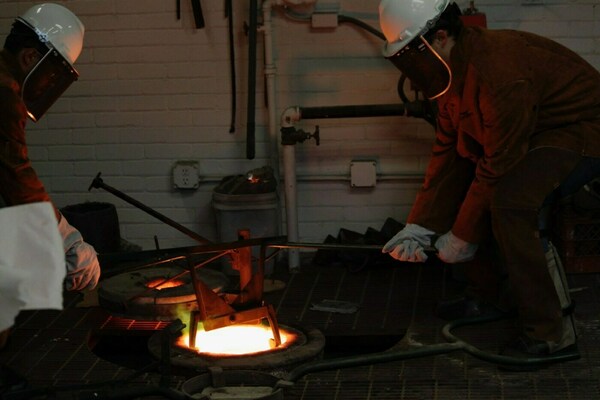
If you are still scrolling through NOVO looking for a class to fulfill the University’s fine arts requirement, sophomore Graeme Marshall has a recommendation for you: Metal Foundry.
“The class is focused on making art pieces by pouring liquid metal into a mold, called a void, and then cooling it,” said chemical engineering major Graeme Marshall.
He was inspired to take the class because he enjoys creating 3D art and, in his free time, sculpts miniatures and dabbles in wax model making.
“I needed an art credit, and pouring molten aluminum and bronze sounded really awesome,” he said.
Marshall described the process of creating projects in Metal Foundry. First, students must carve a mold out of a material like cardboard or wax in the shape they eventually want their metal sculpture to take.
They then press this mold into a sticky, sand-like substance to create a void which the liquid metal will be poured into.
“Think of it like this. You’re on the beach and dug your name into the sand using your finger,” he said. “Then, you fill [the indents made by writing your name] back up with molten metal that will then cool. Once it’s cool, you can pull it out of the sand and you’ve got letters made out of metal.”
He explained that it is necessary to use the sand rather than simply pouring the molten metal into the cardboard or wax mold because sand absorbs heat. It is a good insulator and does not burn which is crucial because the liquid metal is about 2000 degrees — around two times hotter than the average temperature of lava in a Hawaiian volcano.
“We have to wear all-natural fiber full-length pants, long-sleeved shirts and steel-toed leather boots,” Marshall said. “Then on top of that, we put on a leather smock, leather pants and spats — which go over your boots. This way, if some of the liquid metal gets on you, you have time to get it off before it burns through the rest of you. Even then, it’s still dangerous, and we’ve got to be careful.”
Because of the danger inherent to the craft, Notre Dame is one of a select few universities licensed to have a metal foundry. Marshall, a Kentucky native with family in Indiana, said all of the other schools he visited in both states did not have one.
“None of them could even have a class like this,” he said. “So it’s a really unique opportunity even amongst elite institutions.”
But despite this uniqueness, Marshall and his classmates insist that the class is quite accessible to any and all Notre Dame students. Not a single student in the class this semester is an art major — most are engineers or in the College of Science.
Gavin Ealey, a sophomore chemistry major, decided to take Metal Foundry because he likes woodworking and imagined metalwork would be a similar process.
He compares the relationships he and his 10 other Metal Foundry classmates have formed to that of workplace colleagues.
“It’s a lot of joking around,” he said. “There’s a lot of artistic input when people need it, but also weird conversations!”
Due to the intricacy and detail of metalworking projects, the students often spend late nights in Riley Hall of Art and Design touching up their creations in addition to ample class time.
“There’s only 11 of us, and we spend at least three hours together twice a week in class,” said sophomore Keelin Schlageter, another Metal Foundry student. “I don’t think any of us knew each other before this class, but [we’ve gotten] pretty close and are good friends now.”
Marshall agrees that the kinship formed among his classmates makes Metal Foundry even more fun.
“You’ve got to be ready to come in and work outside of class, but it doesn’t feel like work because you’re doing something fun, and you’re normally doing it with another couple [of] people from class,” he said.
“So really, you’re hanging out while you’re doing it[, and] It’s not about how pretty your project is. It’s about how hard you tried and if you understand the principles behind it. As long as you’re willing to put in the work, this class is great and you can’t go wrong by taking it.”
Article originally published on The Observer.